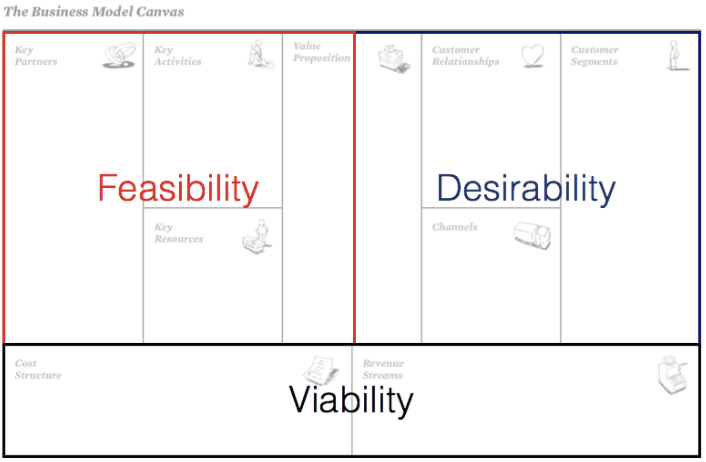Nine Big Business Model Canvas Mistakes
(If you’re using the Canvas, you’ll love my free Business Modelling eBook, full of tips for inventing and testing ideas that will change the world)
Having taught over 220 social entrepreneurs how to use the Strategyzer Business Model Canvas, I’ve found a few ways to shorten the learning curve.
Here are the top nine mistakes, and how you can avoid them.
1. Treating the canvas like a checklist
Many groups see the nine boxes and try to race through them, then declare themselves finished. They missed the point.
There are no prizes for being fast, the aim is to understand the connections and relationships between the boxes.
What activities are required to support your customer relationships?
How does your value proposition influence your choice of channels?
Does each customer segment lead to a revenue stream?
Understanding how each component influences the model is how you gain insight and make sharper decisions.
2. One and done
Once they’ve raced through, entrepreneurs deem themselves finished, pat themselves on the back, and never look at the model again.
What a shame.
The whole point of the tool is that you map out what is, and then map a few versions of what could be.
Get your team to fill one in, what alternative perceptions do they have?
Stuck between a few options?
Compare them on canvases, that often makes things clearer.
Six months later, when you’ve met more customers and partners, made more sales and cleared more hurdles, re-do the canvas with your new knowledge.
You’ll be surprised by how much has changed.
3. Mixing up current and future
Things get dangerous when you start making statements like
"Well we'll have a core group of 2,000 members..."
Be really clear, is this what the model is today, or in 12 months?
Confusing the two defeats the point.
History is precise, future plans are guesses.
By keeping track of your assumptions, you can run better tests, and set better milestones.
4. Confusing customer with beneficiary
This one really hurts Not For Profits.
Customers are people who pay you.
Beneficiaries are the ones whose lives you change.
Sometimes these are the same, sometimes they are separate.
Beneficiaries who don’t pay you are probably partners, not customers.
Think of World Vision, the sponsored child gets the benefits of education and clean water, but they aren’t World Vision’s customer.
The suburban family who donates $400 per year is the customer, and need to be treated accordingly.
5. Confusing Intent with Value Proposition
Your intent is why you run the business, and what matters to you.
Value Proposition is about what matters to the customer, and what they get from you.
The two can be the same or completely separate, and that’s ok.
What’s dangerous is assuming that your motives must be identical.
Customers are allowed to shop with you for self-centred reasons.
Your job is to turn those purchases into social change, and keep the customer coming back.
6. Not putting in numbers
One dangerous mistake is to skip the numbers, opting for broad-brush statements.
The only person you cheat here is yourself.
Let's say your customer segment is “Socially conscious inner city professionals who own two cats and pay top dollar for ethical products”.
How many of these people exist?
Write down the number.
Since it is a finite market, we can’t assume that this group can magically double overnight just because we want them to.
Or perhaps your customer base is wider, how many units can your team sell in a year?
This is even more important when we hit the financials.
How much does it cost to acquire a customer?
How many times does a repeat customer come back in a year?
2 or 20?
This can be a difficult process, but it can save heartbreak (and even bankruptcy) down the road.
7. Misunderstanding Customer Relationships
Customer relationships is the least understood part of the canvas.
Think of it like this: you’ve identified a customer segment, and the value proposition they’re seeking.
Now the question is, how will this interaction unfold?
Gradually, or within seconds?
Online or face-to-face?
Are we expecting repeat business?
Will they describe us as friendly or formal?
This is what the customer relationships box is for; to design and identify how these interactions are best structured for each type of customer.
There is no perfect answer; it’s about choosing an approach that matches what you’re selling.
8. Too much information
The boxes are small for a reason.
The idea is to be brief, and brevity is hard when you have so much to talk about.
The canvas is forcing you to eliminate everything but the essence of your model, the core components that matter most.
Dumping information everywhere hides the essence of the model, which generally leads to poor decision making.
9. Listing features rather than benefits
The features of your products and services are, on the whole, boring.
Sorry to be so blunt, but it’s the truth.
The benefits, however, are fascinating.
That’s what the Value Proposition box is for.
Not the details about how the product works, or what the service involves.
Stick to describing the benefits each customer segment receives, especially the intangible ones (status, confidence, peace of mind, etc).
Features can be included in Key Resources, Key Activities and Channels if you’re desperate to put them somewhere, as these boxes talk about what’s involved in delivering benefits to the customer.
Now is the time to build another canvas.
Use the above list to re-describe your business, and see what changes.
Above all, keep iterating, and keep challenging the old ways of doing business.
You'll enjoy my series on the Business Model Canvas.
If you’d like to jump straight to a particular section, go to:
Overview: How To Use The Business Model Canvas
Desirability: Customer Segments, Value Proposition, Customer Relationships, Channels
Feasibility: Key Resources, Key Activities, Key Partners
Viability: Cost Structure, Revenue Streams










